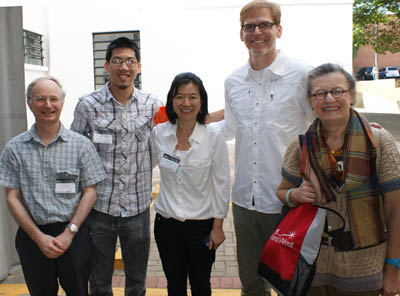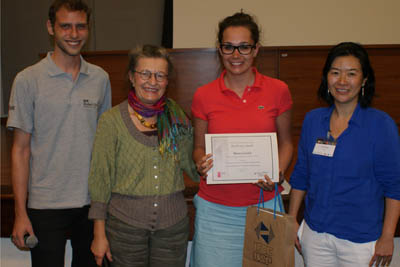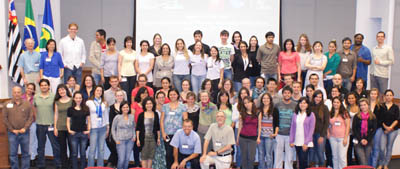
Presenters and students enjoyed an internationally diverse week of prentations during the recent Advanced School on Modern Trends of Biophotonics in São Paolo. Among participants, from left above, were speaker John Girkin (UK), attendee Timothy Quang (USA), organizer Cristina Kurachi (Brazil), speaker Bruce Tromberg (USA), and speaker Katarina Svanberg (Sweden).
SÃO PAOLO, Brazil -- Spectroscopy and nonlinear techniques, PDT, microscopy and imaging, microbiological control, and cancer diagnostics and treatment highlighted sessions at the Advanced School on Modern Trends of Biophotonics for Diagnosis and Treatment of Cancer and Microbial Control earlier this month in São Paolo.
Held at and organized locally by staff at the São Carlos Institute of Physics at the University of São Paolo 11-19 April, the event was sponsored by SPIE, the international society of optics and photonics, and the FAPESP (São Paolo Research Foundation). Co-sponsors were the University of São Paulo (USP) SPIE Student Chapter, MMO, Zeiss, and Thorlabs. Local organizers included USP professors Cristina Kurachi and Vanderlei Salvador Bagnato and researchers Denise Maria Zezell, Lilian Tan Moriyama, and Natálie Mayumi Inada.
The 100 students from 21 countries in South and North America, Europe, Asia, and the Middle East heard talks by speakers from Canada, the UK, Italy, Sweden, and the USA.
SPIE Past President Katarina Svanberg (Lund University) spoke on laser spectroscopy in tumor therapy, and SPIE Board Member Bruce Tromberg (Beckman Laser Institute) spoke on spectroscopy and tissue optics. SPIE Members Brian Wilson (Ontario Cancer Institute) and Timothy Zhu (University of Pennsylvania Health System) were also among the speakers.
"We had a great time during the nine days of the Brazilian Biophotonics School," said Prof. Kurachi. "The students and post-doctoral fellows enjoyed a pleasant environment in which the close contact with top researchers resulted in scientific discussions on advanced topics on biophotonics. The school presented speakers and students from different nationalities, which created a diversity-rich group of attendees. I believe that collaborations and network contacts were established during the school that will contribute to ongoing international exchange of knowledge and human resources."
"Biomedical research at the University of São Paolo Campus São Carlos is outstanding and very promising with very talented leadership of enthusiastic researchers," Dr. Svanberg said. She noted that collaborations between academia, government, and industry in the region are helping to increase biophotonics treatment options for patients, citing an increase in the number of centers using PDT (photo-dynamic therapy) for several types of skin cancer as an example.
A paper describing an efficient method of synthesis, separation, and biofunctionalization of gold nanoparticles for use as probes for biological imaging won the Student Best Paper Award (see photo below).
Tiitled "Gold nanorods and nanoshells -- characteristics and preparation for theranostics applications," the paper was authored by by Marta Gordel (Wroclaw Univ. of Technology and CNRS Ecole Normale Superieure de Cachan), Joanna Olesiak-Banska, Kaytarzyna Matczyszyn, and Marek Samoc (Wroclaw Univ. of Technology), and Claude Nogues and Malcolm Buckle (CNRS Ecole Normale Superieure de Cachan).
The award was funded by the SPIE Digital Library, and included free registration to an SPIE event, a $2,000 travel grant, and an award certificate.
"Students are the future of our field and of the world, and I am proud to actively support their work and their efforts to build careers in optics and photonics," Svanberg said. "Photonics enables advances in basic research as well as applications that improve everyday life. In my own field, oncology, photonics has enabled development of more effective and at the same time less invasive methods of detecting and treating cancer with modalities utilizing lasers and other optical technologies."
The SPIE Student Chapter at the University of São Paolo was established in 2011, and has 18 members. Members are active on campus with seminars and promotion of optics and photonics in conjunction with courses of study and involvement of their school, and have heard invited speakers through the SPIE Visiting Lecturer Program.
Most recently, SPIE Fellow Michael Hamblin (Harvard Medical School, MIT Division of Health Sciences and Technology and Wellman Ctr. for Photomedicine at Massachusetts General Hospital) lectured on photodynamic and low-level laser therapies.
The São Carlos Institute of Physics, an interdisciplinary research center, coordinates several Brazilian research networks in multidisciplinary fields such as optics and photonics, structural biology, ceramic materials, nanobiotechnology, scientific computing and organic electronics.
SPIE is the international society for optics and photonics, a not-for-profit organization founded in 1955 to advance light-based technologies. The Society serves nearly 225,000 constituents from approximately 150 countries, offering conferences, continuing education, books, journals, and a digital library in support of interdisciplinary information exchange, professional networking, and patent precedent. SPIE provided over $3.2 million in support of education and outreach programs in 2012.

Congratulating Student Best Paper Award winner Marta Gordel (third from left) are SPIE USP Student Chapter President Caetano Sabino, SPIE Past President Katarina Svanberg, and school organizer Cristina Kurachi.

A poster session provided the opportunity for authors to answer questions about their work.

Attendees gather for a group photo.
###
Media contact:
Amy Nelson
Public Relations Manager, SPIE
+1 360 685 5478
amy@spie.org
@SPIEtweets